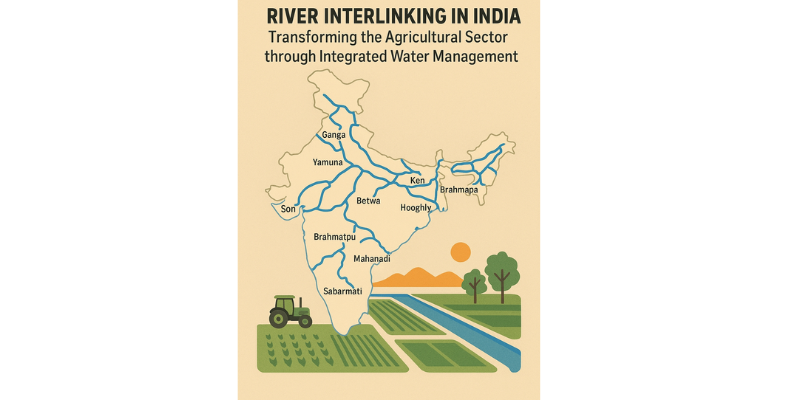India’s diverse topography and climate make it heavily reliant on the monsoon for water supply. However, the irregular distribution of water resources across the country poses a significant challenge to its agricultural economy, which employs nearly 50% of the workforce. In this context, the concept of river interlinking—connecting water-surplus river basins with water-deficit basins through a network of canals and reservoirs—emerges as a revolutionary approach. This ambitious project has the potential to transform Indian agriculture by mitigating droughts, preventing floods, expanding irrigation, and ensuring water security.
1. Understanding River Interlinking
River interlinking involves diverting excess water from rivers with surplus flow to rivers facing water shortages via a complex network of storage dams, canals, pumping stations, and tunnels. The National Water Development Agency (NWDA) proposed a National Perspective Plan (NPP) that includes 30 river-linking schemes categorized under Himalayan and Peninsular plans. These schemes aim to create a comprehensive water grid across India to optimize water distribution.
2. Justification for Interlinking Rivers in Agriculture
The core rationale for river interlinking lies in addressing the regional disparity in water availability. While regions like the Indo-Gangetic plains receive perennial water supply and surplus rainfall, others such as Rajasthan, Vidarbha, and parts of Tamil Nadu suffer acute water scarcity. Agriculture in these drought-prone areas is highly vulnerable to seasonal variations.
Key benefits include:
-
Enhancing net irrigated areas by extending irrigation facilities to water-deficient zones.
-
Boosting productivity in rainfed agricultural regions.
-
Enabling multi-cropping by ensuring consistent water supply.
-
Providing reliable water availability during dry spells.
3. Contributions to the Agricultural Sector
a) Expanded Irrigation Coverage
Interlinking projects will extend irrigation to previously un-irrigated or partially irrigated regions. For example, the Ken-Betwa river linking project is expected to irrigate over one million hectares across Madhya Pradesh and Uttar Pradesh, reducing dependency on erratic monsoon rains.
b) Reduction in Crop Failures
Reliable water supply allows farmers to plan cropping schedules with confidence, minimizing crop failures, enhancing food security, and increasing farm incomes. Consistent irrigation supports better nutrient management, leading to higher yields.
c) Encouragement of Crop Diversification
Regions traditionally limited to drought-tolerant crops can diversify into horticulture, pulses, oilseeds, and floriculture, thereby improving farmer livelihoods and opening new market avenues.
d) Employment Generation
The construction and maintenance of canals, reservoirs, and pumping stations will create jobs, while increased agricultural output supports agro-based industries, processing units, and cold storage facilities, further boosting rural employment.
e) Revival of Traditional Water Bodies
Enhanced water availability aids in replenishing tanks, lakes, and ponds, which act as buffers supporting biodiversity, livestock, and rural ecosystems, thus fostering sustainable village livelihoods.
4. Challenges and Considerations
While promising, river interlinking projects face several critical challenges:
a) Ecological Impact
Altering natural river courses can disrupt aquatic ecosystems and biodiversity, and threaten forest and wetland habitats. Comprehensive Environmental Impact Assessments (EIA) are essential before project implementation.
b) Displacement and Rehabilitation
Land acquisition for infrastructure may displace local communities, causing social upheaval. Fair and transparent rehabilitation and resettlement programs, with community participation, are crucial.
c) Inter-State Water Disputes
Rivers cross state boundaries, making water sharing contentious. Robust legal frameworks and inter-state coordination mechanisms are necessary for peaceful conflict resolution.
d) Financial Viability
High costs for construction, operation, and maintenance demand long-term financial planning and potential public-private partnerships.
e) Climate Change Uncertainty
Changing rainfall patterns due to climate change affect the reliability of donor basins, posing risks that water scarcity might shift rather than resolve.
5. Strategic Recommendations
To maximize benefits and mitigate risks, India should adopt a multi-pronged strategy:
-
Integrated Watershed Management: Promote water conservation through check dams, afforestation, and soil preservation before implementing large-scale river interlinking.
-
Scientific Planning: Utilize updated hydrological data, GIS mapping, and climate modeling for project design and risk assessment.
-
Sustainable Farming Practices: Combine assured water supply with education on efficient irrigation methods like drip and sprinkler systems.
-
Participatory Governance: Involve farmers, local communities, and panchayats in water management and decision-making.
-
Policy Support: Implement reforms to facilitate water pricing, accessible farm credit, and crop insurance to support sustainable agriculture.
6. Conclusion
River interlinking in India represents a visionary solution to the persistent challenge of uneven water distribution, especially for agriculture. When executed with ecological care, financial prudence, and inclusive participation, it can spark rural prosperity. The anticipated increase in agricultural productivity, food sovereignty, and employment will significantly contribute to inclusive growth and sustainable development.
By combining traditional wisdom with modern technology and aligning economic growth with environmental stewardship, river interlinking can become a transformative catalyst for Indian agriculture’s future.
Prepared by
Dr. D. Srinivas
Associate Professor
School of Business
SR University
Warangal, Telangana
